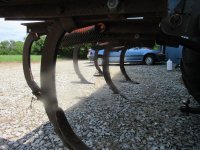DEFINITIONS AG 101 USA-EPA
Field Cultivator -an implement used to perform secondary tillage operations such as seedbed preparation and weed eradication. Field cultivators are equipped with steel shanks that are typically spring mounted to permit the shank to move within the soil and shatter clods.
Field cultivators are constructed similarly to chisel plows, but are more lightly built.
Chisel plows use curved shanks to penetrate and "stir" the soil without inverting a soil layer. Chisel plows cause less residue disturbance than moldboard plows and are often used in conservation tillage systems.
WIKIPEDIA TILLAGE
Reduced Tillage
Reduced tillage[note 1] leaves between 15 and 30% residue cover on the soil or 500 to 1000 pounds per acre (560 to 1100 kg/ha) of small grain residue during the critical erosion period. This may involve the use of a chisel plow, field cultivators, or other implements. See the general comments below to see how they can affect the amount of residue.
Note 1 "CONSERVATION TILLAGE IN THE UNITED STATES: AN OVERVIEW". okstate.edu. Institute of Agriculture and Natural Resources, University of Nebraska Lincoln U.S.A
Specialist ploughs
Chisel plough
The chisel plough is a common tool to get deep tillage (prepared land) with limited soil disruption. The main function of this plough is to loosen and aerate the soils while leaving crop residue at the top of the soil. This plough can be used to reduce the effects of compaction and to help break up ploughpan and hardpan. Unlike many other ploughs the chisel will not invert or turn the soil. This characteristic has made it a useful addition to no-till and low-till farming practices that attempt to maximise the erosion-prevention benefits of keeping organic matter and farming residues present on the soil surface through the year. Because of these attributes, a chisel plough is considered to be more sustainable than other types of plough, such as the mouldboard plough.
The chisel plough is typically set to run up to a depth of eight to twelve inches (200 to 300 mm). However some models may run much deeper. Each of the individual ploughs, or shanks, are typically set from nine inches (229 mm) to twelve inches (305 mm) apart. Such a plough can encounter significant soil drag, consequently a tractor of sufficient power and good traction is required. When planning to plough with a chisel plough it is important to bear in mind that 10 to 15 horsepower per shank will be required.




